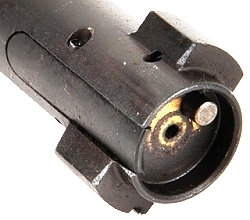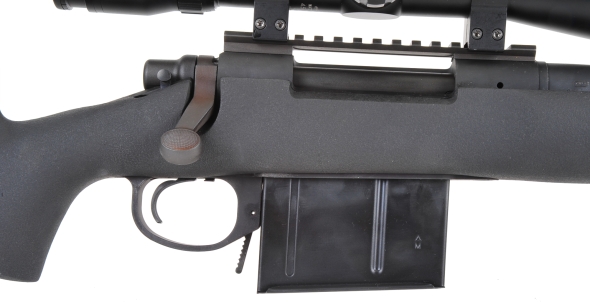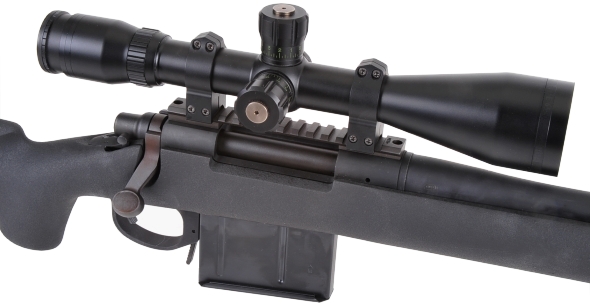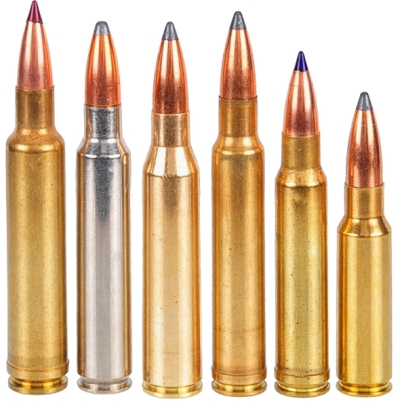
The Remington Model 700 Police is one of the current iteration of the heavy barrel Remington Model 700. Optimized for medium to long range sniper applications, it also fits well for long range competitive shooting and long range big game hunting.
This Remington product type began in 1966 as the Marine Corps choice for a sniper rifle, a replacement for the Winchester Model 70, M1C and M1D sniper rifles used during the earlier stages of the war in Vietnam. Initially, the rifle was not much more than a walnut stocked Remington Model 700, fitted with a 24″ medium heavy barrel, metallic sights, and topped off with a 3-9x Redfield scope. It was chambered for the 7.62×51 NATO.
The original sniper rifle lost its metallic sights, gained an aluminum butt plate and bottom metal and became the M40. In 1977, a number of the existing M40s were upgraded with a McMillan synthetic stock, steel bottom metal and a heavy barrel and given the designated M40A1. In 1980, the same basic rifle received an upgrade with a 10x Unertl scope. In 1988, the Army adopted the Model 700 in similar trim as the basis for the M24 Sniper Weapon Systems.
The Remington Model 700 Police was introduced in 1986, the Lapua version in 2007. The subject rifle is the current evolution with more power, retaining the lineal attributes of exceptional accuracy and precision.
|
Remington Model 700 Police MLR |
|
| Manufacturer | Remington |
| Point of Origin | Ilion, NY |
| Model | 25645 |
| Caliber | 338 Lapua Magnum |
| Magazine Capacity | 5 |
| Barrel / Contour | *26″ / Heavy |
| Twist Rate | 1:10″ 6R |
| Barreled Action | Carbon Steel |
| Metal Finish | Parkerized |
| Scope Mount | D&T 8-40 Fasteners |
| Trigger | 40X |
| Trigger Pull | Adjustable |
| Stock | HS Precision composite |
| Pull | 13 3/8″ |
| Drop at comb | 1 1/4″ |
| Drop at heel | 1 1/2″ |
| Weight | 9 lbs |
| Overall Length | 48.0″ |
| Safety | 2 position |
| MSRP | $2,253 |
|
*Barrel length 27.5″; 26″ active, 1.5″ compensator. |
|
The HS Precision stock is a hand made piece; a CNC machined aluminum bedding block, wrapped in a hand laid lamination of Kevlar, fiberglass and carbon fiber, enclosed in a dense polyurethane foam outer shell shell.

The Model 700P has a spring loaded extractor mounted flush on the outside of the bolt rather than the traditional spring steel extractor located inside the bolt face recess. As other Model 700 Remington rifles, the bolt face encloses the cartridge case head, which is enclosed in the barrel, which is enclosed in the receiver.
The heavy barrel ends in a 20 port muzzle brake. The active portion of the barrel is 26.0″ long, the compensator an additional 1.5″. The muzzle brake is secured with 5/8″-24 threads, which means any muzzle device and be mounted, including a suitable suppressor. The barrel and brake are parkerized as a unit, so the union seam isn’t visible on a new rifle, but it is there as a quick check with a borescope verified. The six groove hammer forged rifling is right hand, the barreled action is made of ordnance steel.

The trigger is fully adjustable externally and of the 40X target rifle type. The bottom metal and AICS spec magazines are interchangeable with any other AICS standard firearm. The magazine release is located just aft of the inserted magazine.

Scope mounting is a bit beefier with a change from 6-48 to 8-40 base mounting fasteners. In this case, a well used Bushnell’s Elite 6500 4.5-30 x 50mm scope was mounted with Warnes steel 30mm rings and Tactical rail. The rail has a 20 MOA vertical offset to keep scope adjustment toward mid range under longer range shooting conditions.

0.338″ makes a popular long range caliber
There are many good 338 caliber magnums, each defined by its ballistics and the rifles for which they are chambered. Bullet weights and types associated magnum cartridges are characterized as having a high ballistic coefficient and sectional density. Below are some examples of mainstream magnums.

| Cartridge | Case Head Dia” |
Case Length “ |
Cartridge Length “ |
Nominal Capacity Grains |
MAP kpsi |
Year Introduced |
| 338-378 Weatherby Mag | *0.582 | 2.913 | 3.763 | 137 | 63.8 | 1999 |
| 338 Remington Ultra Mag | 0.550 | 2.760 | 3.600 | 110 | 63.8 | 2002 |
| 338 Lapua Mag | 0.587 | 2.724 | 3.681 | 108 | 60.9 | **1983 |
| 340 Weatherby Mag | 0.512 | 2.825 | 3.675 | 100 | 63.8 | 1962 |
| 338 Winchester Mag | 0.513 | 2.500 | 3.340 | 86 | 62.4 | 1958 |
| 338 Ruger Compact Mag | 0.533 | 2.015 | 2.840 | 71 | 62.3 | 2008 |
| *Measured above the belt ** Actual commercial CIP approval as the 338 Lapua was in 1897 |
||||||
The 338 Lapua is not the fastest or longest ranging 0.338″ cartridge on the market, nor is it available in the broadest array of firearms. The name suggests the Lapua is of foreign origins, but the 338 Lapua’s origins are as much Finnish as the Bronx, NY created Häagen-Dazs ice cream is Danish.
In 1982, the United States Marine Corp. tasked Research Armament Industries of Rogers, Arkansas to develop a long-range, 1500 meter 1500 m sniper rifle. The result of that effort was a minimal parts design, cartridge changeable Haskins rifle. One type was chambered for the 300 Win Mag, a second for the 50 BMG. The 50 BMG version was accepted and still in use by the military, however, the 300 Win Mag did not meet project penetration criteria.
RAI attempted to use a wildcat version of the 378 Weatherby necked down to .338 caliber. The commercial 338-378 Weatherby didn’t come about until 1999. Unfortunately, the Weatherby’s case belt and minimal body taper did not adapt well to the Haskins rifle. RAI moved on to the .338/416, a wildcat made from necking basis 416 Rigby brass down to accept an 0.338″ bullet, initially a 250 grain bullet made by Hornady. Neither the bullets or brass could meet the design and performance criteria, so RAI turned to Lapua to assist with development in 1984. By 1985 acceptable bullets and casings were ready for U.S. military testing.

Ultimately, only the 50 BMC was of interest to the U.S. Military, the 338/416 had no takers. The RAI company went under, Lapua picked up .338/416 development and partnered with other European companies to finish the cartridge and to produce firearms. The final Lapua version is 2mm shorter than the original .338/416 and the interior of the case was strengthened to handle greater pressures than the original 416 Rigby. Today the .338 Lapua cartridge is a CIP standard, favored as a medium to long range sniper round and utilized by numerous military and police organizations around the world.
.338 Lapua Magnum benefits
The 338 Lapua Magnum has the shortest case of the full length magnums, but one of the longest in overall cartridge length. This means that in long action rifles chambered for the round, long heavy bullets intrude into the case less, conserving valuable powder capacity. Designed as a military cartridge, rather than a sporting rifle cartridge, the absence of a case belt and a bit more case taper that other magnums assures reliable feed and function within difficult environments when a failure to feed or fire means more than missing a shot at a deer.
The biggest gain from the .338 Lapua Magnum over standard .338 and lesser magnum cartridges comes with heavy bullets. At 250 grains, the Lapua cranks out 300 fps more muzzle velocity than a 338 Winchester mag and nearly 1,000 ft-lbs of energy, a difference that carries out beyond 500 yards. Additionally, the Lapua will handle bullet weights of 300 grains that are well beyond the capacity of smaller 338 cartridges.
There are currently thirty six factory loads offered for the .338 Lapua, produced by a pool of eight manufacturers in weights of 215 to 300 grains. The most popular weights are 250 or 300 grains. The lighter weighs fall into the 3,000 fps muzzle velocity range, the 300 grain closer to 2,800 fps. Not a slouch in the bunch. Based on broad acceptance and use by numerous militaries and law enforcement agencies, there should only be a greater supply and diversity of ammo in the future.
Next
The plan at this juncture is to assemble some ammunition, dial in the scope and see how the combination of the Remington Model 700 Police MLR and 338 Lapua suit one another.

Email Notification